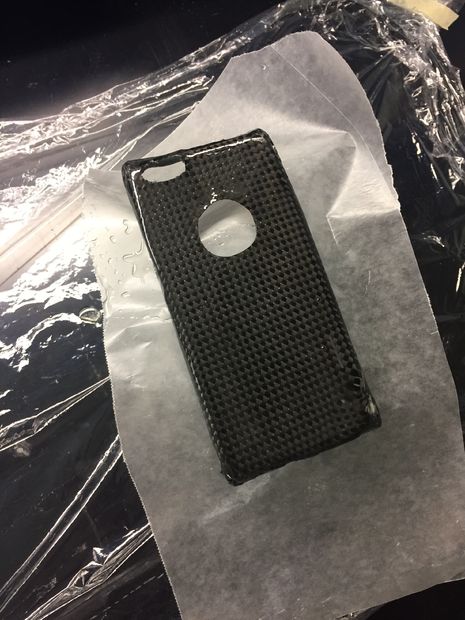You'll start by gathering your materials, which you can find listed in the original post over at the Instructables website. You'll also need to prepare your area by laying plastic wrap down and putting on your apron and rubber gloves. Then, take a sheet of the Glad Press'n Seal Wrap and press it around the inside of the phone case. Now you're ready to begin:
Step 4: Prepare the Plaster
Measure out approximately 3oz of plaster by volume in a dixie cup. Then transfer to the large plastic cup.
Add a small amount of cold water to the 16oz plastic cup and stir thoroughly with a wooden popsicle stick.
The consistency of the plaster should be thick, but still easily pourable. Make sure there are no lumps in the solution.
Continue adding water and stirring until the consistency of the plaster seems correct.
Step 5: Create the Plaster Phone Mold
Pour the plaster into the cell phone case covered in Glad wrap.
The entire case should be full of plaster, and no lumps or bumps should be visible along the top surface. If there are lumps, try to smooth them out with a popsicle stick.
Let the plaster set over the course of 24 hours.
Step 6: Remove the Plaster Mold from the Case
After the plaster has set, gently try to remove the plastic phone mold from the phone case.
Start at the most flexible part of the case, which is usually the corners.
Be careful not to break the mold.
Once it is removed, use a wooden popsicle stick and water to polish down any sharp edges. This mold should resemble the original phone.
When done, set it aside for later use.
Step 7: Prepare the Workspace
Tape down saran wrap all around the work area.
This next process involves epoxy and carbon fibers, both of which can poses hazards. Wear compatible nitrile gloves and a rubber apron.
Step 8: Cutting the Carbon Fiber
Measure the dimensions of your phone (Length x Height), and add an extra inch and a half to each dimension.
Tape out those dimensions on a sheet of carbon fiber. Cut in the middle of the tape, as the tape will keep the edges from fraying and the fibers from separating.
Lay out the carbon fiber sheet in your workspace.
Step 9: Prepare the Phone Mold
Cut out a sheet of wax paper that is the same dimensions as the carbon fiber sheet from before.
Carefully wrap it around the phone mold, and tape down the edges.
Leave a gap in the center of the phone mold, as this will make it easier to remove the carbon fiber lay up from the phone mold later.
Step 10: Lay Up the Carbon Fiber
Lay Up the Carbon Fiber
Wrap the carbon fiber sheet around the phone mold.Make sure the corners of the wrapped case look good.
Tape down the edges to hold it in the desired position, and ensure that the wrap is secure.
Step 11: Mix the Epoxy
Measure out 45mL of the fiberglass resin by volume in one 3oz dixie cup.
Measure out 15mL of the fiberglass hardener by volume in another 3oz dixie cup.
Carefully pour the resin and hardener into the 16oz plastic cup. Use a wooden popsicle stick to scrape any remaining fluid from the dixie cup into the plastic cup. Mix by stirring thoroughly for at least two minutes.
After this, apply the epoxy to the phone case, and then cut out a sheet from the vacuum bag. The sheet needs to be big enough to fit the phone case. Then, cut out a sheet of the vacuum seal tape, leaving an inch or two on each side. Take off the adhesive and seal one side of the bag. Attach the vacuum nozzle and hose to the bag, and then cut another sheet of the vacuum bag seal tape the same size as the first. Put it on the other side of the bag without sealing it, and then place the phone inside the vacuum bag and seal it. Turn on the vacuum and let it run until the epoxy dries. After the epoxy dries, remove the phone case from the vacuum bag, and then use a hammer to crack the plaster and use a screwdriver to remove the remnants.
What do you think of this? Would you make it? What kind of phone case do you use? Share your thoughts and experiences in the comment section below!
Article Source: Instructables
